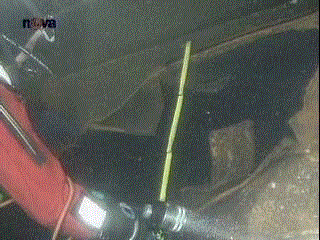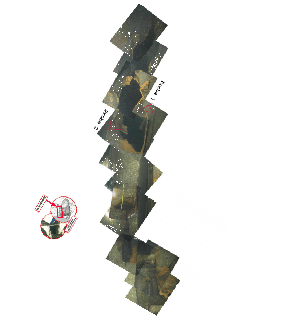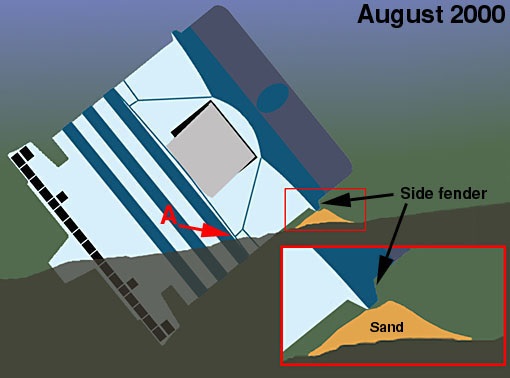2.24 Make a new Investigation according to the IMO Rules. The Diving of Gregg Bemis August 2000
The Final report (5) is not only wrong from A to Z, it is a well written document part of a cleverly planned disinformation program. A passenger ship evidently does not sink in less than one hour or a half hour due to water on the car deck in the superstructure. It capsizes in one minute as the 'Herald of Free Enterprise' and floats upside down on the watertight hull as the 'Jan Heweliusz'.
It is very difficult to sink a leaking passenger ship with its built in intact watertight subdivision in the hull.
All leaking passenger ships sink, if the watertight doors are open and the bilge pump system do not work in the hull.
It is self-evident. But it was not investigated by the Commission.
The Commission spent over three years to 'investigate' only one cause of accident - the visor - and to plant misleading information with the media about it.
None of the 'scientific' reports supporting that cause, done by various institutions like the Royal Institute of Technology, Stockholm, SSPA Marine AB, Gothenburg, or VTT, Helsinki, can be re-done by independent scientists obtaining the same result.
False Model Tests
The results of the SSPA Marine AB model tests are false, and the result is allegedly backed up similarly false 'simulations' of the VTT, Helsinki, as shown elsewhere in this book. It is very serious. These institutions have produced numerous false, scientific reports to hide the true behaviour of the 'Estonia' with water in the superstructure. But even worse - the Final report lies about the most basic facts.
The 'Estonia' lacked Lifesaving Equipment and a correct Evacuation Plan
Elderly passengers had no chance at evacuation and abandoning of the ship. That more than 50% of the persons aboard had to jump overboard and swim to life rafts or ashore is illegal and immoral. But the Commission managed to cover up these facts. Not a word about these evident defects in the Final report (5).
It should today be clear to anybody today that the visor was detached from the ship after the accident - the listing - and that the ramp protecting the superstructure was never open at all.
However, the Commission 1994 boldly blamed the whole accident on the visor - in particular badly designed and manufactured visor locks (sic) made 1980. The Commission was so certain in its manipulations, that it was not until 14 months after the accident 1.22, when it officially contacted the shipyard about how the locks had been made, designed and manufactured (informal contacts had been established earlier). The replies from the yard (17), (18) from 1996 were then made secret by the Swedes and were not included in the Final Report (5) in December 1997 (the German letters did not become public until 1998 - three months after the publication of the Final Report). But strangely enough the Germans did not protest too loudly about it in their own Final report 3.18.
The German yard arranged two exhibitions about its findings at Stockholm 1997. There was a fair attendance - a couple of thousands people - but the media did not report a lot about it. The Commission never visited the exhibitions.
Survivors and relatives to victims have evidently not got a satisfactory explanation of the accident. Most associations of relatives have bitterly complained but were and still are ignored by the authorities. The Swedish government is 100% responsible for this. All statements from various government agencies, that the Final Report not only is complete, but that the suggested sequence of events is correct and that the cause of accident is realistic, have no foundation. There is no evidence for any alleged official facts. Again victims and witnesses of casualties at sea are not given a fair treatment.
The Swedish daily Dagens Nyheter, in its editorial 16 November 1998 with the heading 'Saving lives is most important', emphasised that new disasters can be avoided and that serious analysis and discussions are important to reduce the risks for new accidents. The editorial was written for the ITF/NTF conference on 18 November 1998, where the Commission for the first time agreed to reply to any questions about its investigations 2.7.
But the Commission would or could not clarify anything. Ann-Louise Eksborg, the SHK boss, later announced that she had no intention to discuss the Final Report with anybody 3.19. The Swedish government gave 1998-2001 similar information. The best strategy when you have started a disinformation campaign is silence - more lies only complicate matters.
Saving Lives is not the most important
It is probably more important to save the careers of the incompetent investigators and the persons who instructed or assisted the investigators to cover up the crime. It is quite sad actually.
The Swedish Analysis group 1.36 surprisingly recommended 1998 that all victims should be salvaged and that a new examination of the wreck should be done. It was probably not a serious recommendation. It was part of the Swedish government's tactic to confuse the relatives, and the Swedish government naturally later ignored the recommendation. And neither salvage of victims nor an examination of the wreck was and is necessary to clarify the 'Estonia' accident to find answers to all outstanding questions. It is only to appoint a new Commission as per the IMO resolution A.849 (20) and ask it to review all new facts that have been presented, which are not examined or mentioned in the Final Report (5). Not one essential alleged fact in the Final report is true. The Swedish government has not since 1997 once informed the public that an agreed procedure already exists to resolve the outstanding questions of safety at sea after the 'Estonia' disaster. The public need facts and clear analysis. But Sweden, Finland and Estonia do not follow the international resolutions and laws for marine accident investigations. The Swedish government - Mona Sahlin in particular - always tries to show empathy with the relatives - yes, the outstanding questions must be clarified, but the Finnish and Estonian governments do not want to appoint a new investigation Commission. So what?
· We cannot compromise about safety at sea, as all of us want the highest safety at sea.
· Means for improved safety at sea shall be realistic, safe and economical.
· Extreme interests of particular groups do not help anybody and do not contribute to safety at sea.
The work of the Commission evidently supported the extreme interests of particular groups not interested in the Truth about the accident or safety at sea. The Commission must have known that they just played the music of the disinformation campaign.
It is not necessary to make a new dive examination to investigate the new facts of the accident. Just examine the facts! Until then the wreck will attract all sorts of attention to find out what actually happened.
The Gregg Bemis Dive Expedition
The Gregg Bemis dive expedition in August 2000 was one such attempt. The films then made clearly show that the Commission did not present all facts
The expedition started from Cuxhafen in Germany with participants from several countries, which had not signed the law preventing diving on the 'Estonia' 1.19. After having passed the Kiel Canal they stopped at Kiel to embark three German journalists. Swedish authorities had been invited to participate as observers but the Swedish government never replied. The expedition was supervised by Swedish and Finnish coastguards (airplanes and ships) and the Estonian navy. A number of boats with media representatives supervised both the Bemis ship and the coastguard boats.
|
The Swedish and Finnish coastguard boats contravened international sea traffic rules to prevent Bemis to anchor on top of the wreck, but as the media followed the drama, the attempt failed. The Swedish and Finnish coastguard then visited the Bemis ship and announced that diving was against their law. They also wanted to know the names of the persons aboard. The Master on the Bemis ship only replied that the unilateral law did not concern anybody aboard. The first stage of the expedition was to check the wreck with sonar. Then diving started. A buoy was positioned over the bow of the wreck and was secured to the top of damaged port collision bulkhead, 1.16 and 3.10. This line was then used for getting up and down. Two diving teams then filmed various parts of the wreck. The most interesting part of the examination is of course the big opening in the starboard collision bulkhead, which is discussed in other chapters of this book and which is shown to the right. The damage opening is just above the visor side lock two meters below the top of the bulkhead. The Commission denies that the damage exists. |
|
The last day they also filmed the wreck by an ROV, when a sand heap was noticed on the superstructure side, which might have hidden an opening in the starboard superstructure side (>2 meters above the waterline). This sand heap might in fact hide the starboard pilot door leading into the car deck space 1.16.
|
When the ROV filmed the sea floor it collided with an object covered by a thin layer of mud. The object was the body a dead man - no doubt about it. It must be pointed out that the Bemis expedition lacked facilities to examine the whole wreck or hull by divers in detail for damages. They could only examine a few locations and a very small area at every location. The effective dive time per team was only 20 minutes and a lot of time was used just to have a look around. Unfortunately the divers did not examine particularly interesting areas, e.g. the deck beam at fr. 159 on the fore castle deck (the Commission suggests that the beam is cut off by the visor hydraulics, but it is not possible) or the starboard side just above the bilge, i.w.o. the sauna/pool compartment and the heeling tank (where this writer believes there is a long fracture). |
|
Both these areas are not shown on the edited films made by the Commission and available to the public. There are other areas in the fore ship structure, where the Germans have spotted damages apparently due to 'explosives', which were not examined by the Bemis divers. One Bemis diver however managed to get inside the ramp and have a look. As the ship was resting on the side, the port bulkhead inside the ramp was like a ceiling above the diver. It was thus easy to inspect that bulkhead. It appeared to be intact, i.e. there were no damages caused by, e.g. explosive devices as suggested by the Germans. The starboard bulkhead inside the ramp was like a floor and it was covered by a layer of silt and could not be examined in detail. Strangely enough various objects were resting on the starboard bulkhead. How these objects could have ended up there is not known.
|
Test Pieces from the explosive Damage Divers went down to cut off two test pieces from the edges of the opening found in the starboard collision bulkhead: 3.10 for the exact position of these pieces. Four different material test laboratories have later been asked to analyse the pieces - if the material e.g. has been subject to an explosion. Various laboratory results have been published. Interestingly enough the above pictures of the damage in the forward bulkhead has never been shown in Swedish and Estonian TV or media. The opinion of this writer is simple as usual. The opening cannot have been torn open by e.g. the visor lifting hydraulics. Then the edges of the hole should consist of bent steel plate. Now there is an opening with some edges cut off and some bent outwards and a lot of material missing. It is probable that an explosive device fitted on the inside of the collision bulkhead caused the damage, probably in an attempt to remove the visor under water! |

Figure 2.24.3 Diver prepares cutting off a test piece from the damage |
It is an established fact that the damage opening in the collision bulkhead, where the test pieces were cut out, has never been announced or explained by the Commission to the media and public. The Commission made great efforts to hide the opening during the investigation - films taken on 2 and 9 October and 2-4 December 1994 have been edited not to show the relevant area. The Commission has stated that the area is intact 1.4. However - the Commission overlooked one thing - the visor itself! Figure 8.20 in the Final Report shows the aft starboard bulkhead of the visor, which rested about 5-10 centimetres in front of the collision bulkhead. The picture is taken just after the visor was salvaged. You can see that the white paint is full of black soot below the side lock and that the plate is slightly buckled. Thus - the opening in the collision bulkhead is not in line with the buckled area with soot below the side lock on the visor, when the visor is closed. If the two damages - one in the collision bulkhead and the other on the visor itself - are connected, the visor must have shifted place, i.e. the visor must have shifted upwards when e.g. the hole in the bulkhead was blown open and caused the soot and the buckle in the visor. It is possible that this shifting of the visor had occurred under water, when the ship sank and that the visor was in fact attached to the wreck. There are many indications that the visor was detached from the wreck under water.
However - the only result in Sweden of the Bemis dive expedition was that Mr. Bemis himself and a German journalist were arrested in their absence for alleged crimes of graveyard peace. But as one of the Czech divers told the writer, when he first saw the above picture in January 2001:
"Bigamy is evidently forbidden in my country, but we do not arrest Muslim visitors with several wives coming on a visit. To dive on the 'Estonia' is not forbidden according to Czech laws and to threaten Czech citizens with prison in Sweden is disturbing. It reminds a lot about the condition in the ex-CSSR, where the people with power manipulated the media and public with unfair laws 1945-1990".
Germany has in January 2001 definitively refused Swedish pressure to make the graveyard peace law also German law. One reason is that the 'Estonia' accident is part of an alleged murder investigation in Germany. That the Czech republic is going to adopt the graveyard peace law is unlikely.
It must be repeated. The Bemis films were shown in Swedish TV-4 during the autumn 2000 and a number of so called 'experts' were invited to discuss the so called 'hole' in the starboard side - it did not exist. But the picture of the big hole in the forward collision bulkhead was not shown on TV or discussed by the experts in spite of being clearly visible on all films (in February 2001 by the writer). The writer finds this very disturbing.
The German journalist is Ms Jutta Rabe. She presents her findings at http://www.balticstorm.com and in a book published 2002.
---

